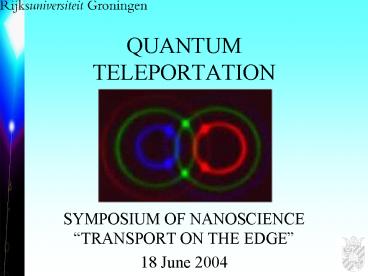QUANTUM TELEPORTATION - PowerPoint PPT Presentation
1 / 16
Title: QUANTUM TELEPORTATION
1
QUANTUM TELEPORTATION
- SYMPOSIUM OF NANOSCIENCE TRANSPORT ON THE EDGE
- 18 June 2004
2
Introduction
Quantum teleportation transfer of the
information of an object without sending the
object itself
- How does it work?
- Realization
- Why does it work?
- Debate in quantum mechanics
'Star Trek' teleporter nearer reality June 17,
2002 Posted 1247 AM EDT (0447 GMT)
CANBERRA, Australia -- It's not quite "Star Trek"
yet, but Australian university researchers in
quantum optics say they have "teleported" a
message in a laser beam using the same technology
principles that enabled Scotty to beam up Captain
Kirk.
CANBERRA, Australia -- It's not quite "Star Trek"
yet, but Australian university researchers in
quantum optics say they have "teleported" a
message in a laser beam using the same technology
principles that enabled Scotty to beam up Captain
Kirk.
3
Lets Meet Our Key Figures
God does not play dice with the universe -Albert
Einstein
Anyone who is not shocked by Quantum Theory has
not understood it -Niels Bohr
4
The EPR Paradox Non-locality in Quantum Mechanics
- 1935 Paper by Einstein, Podolsky, and Rosen
stating a paradox in quantum mechanics - Quantum mechanics is a local, but incomplete
theory - There might be so-called hidden variables that
complete quantum mechanics
Locality No instantaneous interaction between
distant systems
Einstein, A., Podolsky, B., Rosen, N. (1935)
Physical Review 47, 777-780
5
The EPR Paradox Idea
Assumptions -Quantum theory is local - Wave
function forms complete description
Two particle quantum system Neither position nor
momentum of either particle is well defined, sum
of positions and difference of momenta are
precisely defined
Quantum mechanics Two non commuting quantities
(e.g. position and momentum) can not have a
precisely defined value simultaneously
Measurement Knowledge of e.g. the position of
particle 1, gives the precise position of
particle 2 without interaction, position and
momentum can be simultaneously defined properties
of a system
Paradox
6
Experimental Realization of the Paradox I
source
-1
-1
1
1
photon 2
photon 1
q
f
Two entangled photons 1 and 2 emitted from a
source impinge on polarizing analyzers
- Test with polarization entangled photons
- Entanglement creation in same process,
interaction - No product state but superposition
Adapted from Bohm, D., Aharonov, Y. (1957)
Physical Review 108, 1070-1076
7
Experimental Realization of the Paradox II
- Violation of Heisenbergs principle if
correlation noise has values below zero
confirmation of paradox - For some phases the noise is lower than zero
The phase sensitive noise (iii) for some phases
(f10, f20) was lower than the noise level of the
signal beam alone (i) implying violation of
Heisenbergs principle
Ou, Z.Y., Pereira, S.F., Kimble, H.J. (1992)
Applied Physics B 55, 265-278
8
Solution to the Paradox
- 1964 J. Bell states inequalities for hidden
variable theories - Inequalities correct local hidden variables,
quantum mechanics is local - Inequalities incorrect no hidden variables,
quantum mechanics is complete and non-local
P(a,b) Expectation value of the measurement
outcomes
Bell, J.S. (1964) Physics 1, 195-200 Clauser et.
Al. (1969) Physical Review Letters 23,880-884
9
Is Quantum Mechanics Complete
- Experiments showed Bells inequalities to be
incorrect - No hidden variables quantum mechanics is
complete and non-local - Non-locality essential idea for quantum
teleportation
Average coincidence rate as a function of the
relative orientations of the polarisers. The
dashes line is the quantum mechanical prediction
and shows excellent agreement with the experiment.
Aspect, A., Dalibard, J., Roger, G. (1982)
Physical Review Letters 49, 1804-1807
10
Quantum Teleportation
- Correlations used for data transfer
- Teleporting the state not the particle
- Entanglement between photon 1 and 2
- Bell state measurement causes teleportation
Schematic idea for quantum teleportation
introducing Alice as a sending and Bob as a
receiving station, showing the different paths of
information transfer.
Bouwmeester, D., et. Al. (1997) Nature 390,
575-579
11
Entangled States
- Parametric down-conversion
- Non-linear optical process
- Creation of two polarization entangled photons
- Pulsed beams
E1
w
k(1)w
wp w w
Pump
wp
kwp k(1)w k(2)w
Ep
kwp
Ep c(2)E1.E2
w
k(2)w
c(2)
E2
Parametric down-conversion creating a signal and
idler beam from the pump-pulse. Energy and
momentum conservation are shown on the right
side.
12
Bell State Measurement
- Projects onto the Bell states and entangles
photons - Use of a polarizing beamsplitter
- transmits vertically polarized light
- reflects horizontally polarized light
There are four possible outcomes of the
beamsplitter that can be determined by putting
detectors in their paths. In the lower image it
can not be said which photon is which they are
entangled
13
Experimental Realization
- UV pulse beam hits non-linear crystal twice
- Threefold coincidence f1f2d1(45) in absence of
f1f2d2 (-45) - Temporal overlap between photon 1,2
Experimental set-up for quantum teleportation,
showing the UV pulsed beam that creates the
entangled pair, the beamsplitters and the
polarisers.
Bouwmeester, D.,et. Al. (1997) Nature 390, 575-579
14
Experimental Demonstration
Theoretical and experimental threefold
coincidence detection between the two Bell state
detectors f1f2 and one of the detectors
monitoring the teleported state. Teleportation is
complete when d1f1f2 (-45) is absent in the
presence of d2f1f2(45) detection.
Bouwmeester, D., et. Al. (1997) Nature 390,
575-579
15
Teleportation of Massive Particles
Quantum teleportation step by step following
the original protocol
Kimble, H.J., Van Enk, S.J. (2004) Nature 429,
712-713
16
Conclusion
- Promising technique, still to be optimized
- Beam me up, Scotty reality?
- 100 vs. 1029 atoms
- fidelity not 100
- Use as data transport in quantum communication
- quantum cryptography
- quantum dense coding
- Quantum computing































